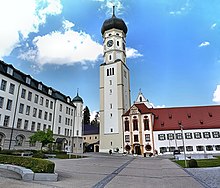St. Johannes Evangelist (Ursberg)
The Catholic parish church of St. Johannes Evangelist and Petrus is a former collegiate church of the Premonstratensian order in Ursberg , a parish in the Bavarian-Swabian district of Günzburg .
history
A first church building from the time the monastery was founded was restored after a fire in 1142. Under the provosts Burchard and Konrad von Lichtenau, a new building was carried out, which began around 1224 and was consecrated in 1230. The newly created basilica had three naves and probably three apses . In the 15th century these were renewed in a polygonal shape.
After a fire during the Thirty Years War , the church and the monastery were completely destroyed. The reconstruction using the Romanesque walls took place from 1666 to 1674. The abbot Matthäus Hochenrieder commissioned the master mason Christoph Weigel from Oberrohr as master builder. A vestibule was added and the central nave was raised. In 1622 the octagonal octagon of the tower was added, the onion was not added until 1654.
After the completion of the church, the monastery was rebuilt, also under Christoph Weigel. Provost Wilhelm III. In 1776, Schöllhorn had the church and monastery redesigned in the late Rococo style by the Wettenhausen monastery master builder Joseph Dossenberger the Younger . The ceiling frescos by Jakob Fröschle and Konrad Huber were also created during this time . After the secularization, the collegiate church was preserved as a parish church .
Furnishing
Jakob Fröschle created the stucco and frescoes in 1776, Konrad Huber painted the three ceiling paintings in the side choir in 1794. The high altar by Johann Wagner and Johann Pflaum is from 1733, the altar sheet by Konrad Huber from 1794 shows the Assumption of Mary . The side figures represent the church patrons Peter and Johannes and the order's founders Augustine and Norbert as well as the Annunciation. The two small side altars from 1778 show St. Francis on the left and St. John on the right.
The altars in the side aisle were built around 1775 with a structure from 1689 and are flanked by the side figures, on the left St. Wolfgang and St. Aegidius, on the right St. Sebastian and St. Rochus, in the excerpts St. Catherine and St. Stephen. The choir stalls are from 1686. The pulpit was added in 1777. Also worth mentioning is the Romanesque cross from the first third of the 13th century with the assistant figures of the Holy Mother of God and the Evangelist John. It has been in the choir since 2003.
Organs
Main organ
The main organ was built in 1776 by the organ builder Johann Nepomuk Holzhey . The instrument has 26 stops on two manuals and a pedal .
|
|
|
||||||||||||||||||||||||||||||||||||||||||||||||||||||||||||||||||||||||||||||||||||||||||||||||||||||||||||||||||||||||||||||
- Coupling : II / I, I / P
Choir organ
The church has a smaller choir organ, which was also built by Holzhey. As usual in southern Germany, the instrument is divided into two parts, which are in the choir on the left and right. The slider chest instrument has 11 registers, distributed on a manual and pedal.
|
|
|||||||||||||||||||||||||||||||||||||||||||||||||||||||||||||||||
- Pairing : I / P
Grave slabs
- Provost Konrad von Lichtenau († 1240)
- Heinrich von Rain († 1378)
- Hans von Freyberg († 1483)
- Abbot Georg Lechler († 1575)
- Abbot Thomas Mang († 1569)
- Abbot Jakob Miller († 1595)
Peal
The tower has four historical bells:
|
No. |
Name (dedication) |
Casting year |
Caster |
Mass (kg, approx.) |
Percussive ( HT - 1 / 16 ) |
| 1 | Big bell | 1653 | Honor and Claudius & Johann Demerge, Lorraine | 1250 | d¹ |
| 2 | Twelve | 1736 | Johann Weber, Augsburg | 600 | fis¹ |
| 3 | Elferin | 1764 | Philipp Abraham, Augsburg | 250 | c² |
| 4th | Little bell | 1750 | Johann Baptist, Augsburg | 225 | cis² |
See also
literature
- Bruno Bushart , Georg Paula : Georg Dehio - Handbook of German Art Monuments / Bavaria Bd. 3 - Swabia. Deutscher Kunstverlag 2008, ISBN 978-3-42203116-6 , pp. 1050-1053.
Web links
Individual evidence
- ↑ Ursberg - travel guide of the Premonstratensians. Retrieved January 27, 2020 .
- ↑ Dean Ludwig: Glory to God in the highest. Retrieved January 27, 2020 .
- ↑ Egon J. Greipl: Power and splendor: the history of the residences in Franconia, Swabia and Old Bavaria . Pustet, 1991, ISBN 978-3-7917-1249-9 ( google.de [accessed on January 28, 2020]).
- ^ Alfred Lohmüller: Reichsstift Ursberg: from the beginnings in 1125 to the year 1802 . 1987, ISBN 978-3-87437-249-7 ( google.de [accessed on January 28, 2020]).
- ↑ Werner Schiedermair: Klosterland Bavarian Swabia: in memory of the secularization of 1802/1803 . Fink, 2003, ISBN 978-3-89870-127-3 ( google.de [accessed on January 28, 2020]).
- ↑ Information on the main organ
- ↑ Ursberg - St. John Evangelist - full bell. Retrieved January 27, 2020 .
- ^ Günther Grundmann: German Bell Atlas . Deutscher Kunstverlag, 1959 ( google.de [accessed January 28, 2020]).
Coordinates: 48 ° 15 '59.5 " N , 10 ° 26" 43.8 " E




